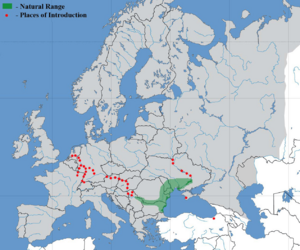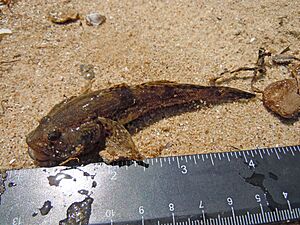Bighead goby facts for kids
Quick facts for kids Bighead goby |
|
|---|---|
 |
|
| Conservation status | |
| Scientific classification | |
 |
|
| The range of the bighead goby |
The bighead goby, also known as Kessler's goby, is a type of goby fish found in Eurasia. This fish is a "relict" species, meaning it's a survivor from a time when the Ponto-Caspian Sea was much larger. It lives in both fresh and slightly salty (oligohaline) waters. It can handle water with very low salt content, from almost zero up to 1.5-3.0 parts per thousand.
Contents
What the Bighead Goby Looks Like
This fish has a large, flat head and a very wide upper lip. Its body is shaped like a cone, getting thinner towards the tail. Its lower jaw is longer than its upper jaw. It can grow up to 22 centimeters (about 8.7 inches) long.
You can spot a bighead goby by a dark, triangle-shaped mark near its tail fin. It has a special sucker on its belly, which helps it stick to things. This sucker has small flaps around its edge and does not reach its anus. The fish is usually red-brown or grey-brown. It has five dark stripes across its back, with one stripe right at the base of its tail fin. Its head has light, round spots with white edges on the sides. The base of its side fins has wavy brown spots, and its other fins have lines of black spots.
Where the Bighead Goby Lives
Its Natural Home
The bighead goby is naturally found in the lagoons and estuaries of the northwestern Black Sea. This includes areas near the Bulgarian coast, especially in lakes like Mandra, Vaya, Varna, and Beloslavsko. In the Danube River, it used to live as far up as Vidin and was common in the lakes of the Danube delta. It also lives in rivers like the Dniester (up to Kamianets-Podilskyi), and smaller rivers like the Zbruch and Bystrytsia. You can also find it in the Dnieper River (up to Dnipropetrovsk) and the Southern Bug River.
Spreading to New Places
The bighead goby has started to spread to new areas. It was first seen in the Slovak part of the Danube River in 1996. By 2004, it was the most common type of goby there. It has also been found in the Tisza River and in the upper Danube, reaching parts of Austria and Germany up to the city of Straubing. Between 2000 and 2002, it was seen in small streams along the Black Sea coast of eastern Turkey.
Since March 2009, this fish has even been found in the North Sea basin, specifically in the Waal River in the Netherlands. In 2009, bighead gobies made up more than half of the gobies caught in the German part of the Lower Rhine River, between Cologne and Rees. By 2011, its range included the Rhine River in Germany, France, and Switzerland, as well as the French part of the Moselle River.

What the Bighead Goby Eats
In the Dniester Estuary, the bighead goby mainly eats other fish, which makes up most of its diet (up to 92% by weight). It also eats small crustaceans like Corophium chelicorne and Paramysis intermedia, which make up about 7% of its food. Molluscs (like snails or clams) and polychaetes (a type of worm) are less important parts of its diet.
Who Eats the Bighead Goby and Its Parasites
The bighead goby is an important food source for other predatory fish, such as zander.
Like many animals, the bighead goby can have parasites. In the Dniester Estuary, it can host trematodes (a type of flatworm) called Nicolla skrjabini and larvae of nematodes (roundworms) called Eustrongylides excisus. In the Middle Danube River, this goby can carry 33 different types of parasites. Some common ones include acanthocephalans (spiny-headed worms) called Pomphorhynchus laevis, glochidia (larvae) of Anadonta anatina molluscs, and nematodes like Raphidascaris acus. It can also host the larvae of an invasive nematode from the Far East called Anguillicoloides crassus.
In the Austrian part of the Danube, five types of parasites have been found in the bighead goby. These include Trichodina (a type of infusoria), Ergasilus sieboldi (a parasitic crustacean), Diplostomum and N. skrjabini (both trematodes), and Acanthocephalus lucii (an acanthocephalan).


